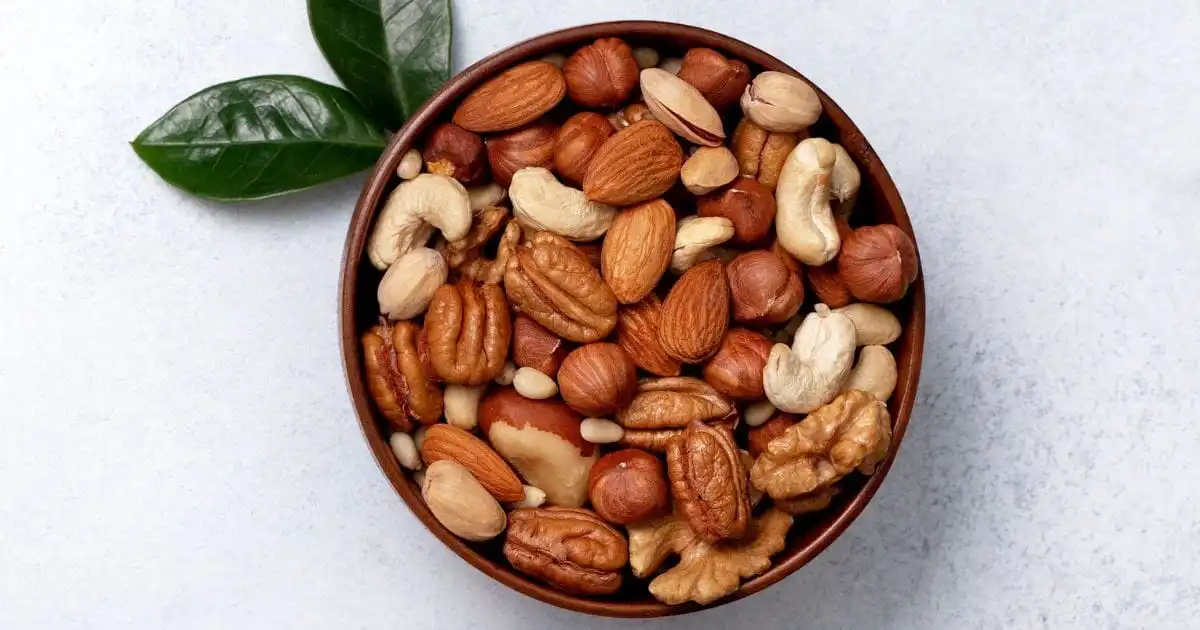Updated on April 28th, 2024
As the candy bar slogan goes, “Sometimes you feel like a nut. Sometimes you don’t.” The thing is, if you don’t know what nuts taste like, you definitely won’t know if you’re in the mood for nuts. So let’s explore the wacky world of nuts and their addictive flavors.
About nuts

Botanically speaking, nuts are fruits that don’t open to release their seeds. But here’s a fun twist: Not all snacks we call “nuts” are nuts in the botanical sense. Some are technically the seeds of drupe fruits and some are actually legumes:
- Acorns, hazelnuts, beechnuts and chestnuts are true nuts.
- Peanuts and soy nuts are legumes.
- Brazil nuts, walnuts, pecans, macadamia nuts, pistachios, and pine nuts, are seeds.
Certain legumes and seeds are grouped into the nut category because they have similar nutritional profiles and similar uses in cooking and snacking. That nutritional profile includes protein, healthy fats, and various vitamins and minerals. And the shared uses include:
- Energy-boosting snack
- Source of satisfying crunch and flavor in recipes, commonly salads and desserts
The taste of nuts
Nuts generally have a rich, savory flavor and a delightful crunch. The taste varies quite a bit from one type of nut to another, however. So let’s explore some popular types of nuts and what each tastes like.
Peanuts
The taste of peanuts is both subtly sweet and delightfully earthy. These little guys also have a distinct aroma plus a creamy, almost buttery texture.
The flavor and texture of a peanut can be easily enhanced, too. Salt provides a bit of savoriness that complements the natural sweetness. And roasting deepens the savory notes and provides a richer texture.
Hazelnuts
Raw hazelnuts have a woody flavor that can be almost musty. Their skins can be bitter, too.
If you remove the skins and roast hazelnuts, the flavor deepens and balances. It becomes a sweeter, creamier version of that woody flavor.
Roasted hazelnuts go particularly well with chocolate, which is why they’re used in Nutella spread and Ferrarro Rocher candies. Frangelico liqueur is also hazelnut-flavored.
Almonds
Almonds have a mild, slightly sweet and nutty flavor. They possess a hint of bitterness due to their skin — but you can pop off the skin to reveal a smoother, creamier taste.
Raw almonds have a firm, crunchy texture that softens slightly when roasted. Roasting also enhances their nuttiness, bringing out a richer and more intense flavor.
Almonds are very versatile and used in a variety of culinary applications, ranging from sweet dishes like marzipan and pastries to savory almond butter and salads.
Cashews
Cashews have a mild, buttery taste with a slightly sweet flavor. They are less nutty compared to other nuts like almonds or hazelnuts. Their creamy texture distinguishes them from crunchier nuts, and makes them a candidate for blending smoothly into sauces and spreads.
When roasted, cashews develop a richer flavor with enhanced sweetness and nuttiness. They’re a delicious snack and also complement many dishes from stir-fries to desserts.
Pine nuts
Pine nuts, also known as pignoli, have a delicate, slightly sweet flavor with a buttery, resinous undertone. They are rich and creamy in texture.
Pine nuts are often toasted to enhance their mild nuttiness and to bring out a slightly earthy aroma. This toasting process also adds a bit of crunch to their otherwise soft texture. They are commonly used in Mediterranean and Middle Eastern cuisine, in dishes like pestos and salads.
Pistachios
Pistachios have a unique, mildly sweet and nutty flavor with a hint of earthiness. They are less sweet than, say, almonds or cashews. But pistachios do have a distinctive taste that is sometimes described as slightly fruity.
Pistachios have a slightly creamy texture when fresh, which becomes crunchier when roasted. Roasting also intensifies their flavor, bringing out a richer and more pronounced nuttiness. These characteristics make pistachios a popular choice for snacking, as well as for adding to both sweet and savory dishes, such as ice creams, pastries, and salads.
Pecans
Pecans have a rich, buttery flavor with a hint of sweetness and a mildly earthy undertone. They are known for their soft, yet crunchy texture which becomes more pronounced when they are toasted or roasted.
Roasting pecans enhances their natural flavors, bringing out a deeper, caramel-like sweetness and intensifying their nutty essence. Pecans are often used in baking, particularly in pies and other desserts, but they are also excellent in savory dishes like salads, or as a crunchy topping for various dishes.
Chestnuts
Chestnuts have a unique flavor profile compared to other nuts. They are mildly sweet and starchy, with a slightly earthy taste.
When cooked, chestnuts develop a tender, almost potato-like texture, which is quite different from the crunch of most other nuts. Roasting chestnuts enhances their natural sweetness and imparts a slightly smoky flavor.
They can be enjoyed on their own as a roasted snack or used in various culinary preparations, including stuffings, soups, desserts, and even ground into flour for baking.
How to eat nuts
Many types of nuts can be eaten as snacks. They’re often roasted and salted to enhance the natural flavor and texture.
You can also use different types of nuts in many types of recipes, ranging from savory to sweet flavors. Popular recipes that feature nuts include:
Nuts are a versatile ingredient used in a variety of dishes around the world. Here’s a list of some of the most popular dishes that feature nuts prominently:
- Pesto: Traditional Italian pesto is made with basil, garlic, Parmesan cheese, olive oil, and pine nuts blended into a thick, green sauce that’s typically served with pasta.
- Baklava: Baklava is a sweet dessert from the Middle East made with layers of filo pastry, filled with chopped nuts like pistachios or walnuts, and sweetened with honey or syrup.
- Pad Thai: This popular Thai dish often includes crushed peanuts sprinkled on top of stir-fried rice noodles with eggs, tofu, and vegetables, seasoned with tamarind, fish sauce, and chili.
- Peanut Butter Cookies: A classic American treat, these cookies are made with peanut butter as a primary ingredient, giving them a rich and nutty flavor.
- Cashew Chicken: Cashew Chicken is a popular Asian dish featuring fried chicken and stir-fried vegetables.
- Pralines: A type of candy originating from France, made from almonds or pecans and caramelized sugar.
- Chicken Satay: A Southeast Asian dish featuring skewered and grilled meat, often served with a spicy peanut sauce.
- Marzipan: A confection made primarily from sugar and almond meal, often shaped into fruits and used as a decorative cake topping.
- Brittle: A type of candy that includes nuts like peanuts or almonds embedded in hard sugar candy.
- Granola: Typically made from rolled oats, nuts, honey or other sweeteners, and sometimes dried fruit, which is baked until crispy.
- Walnut Stuffed Dates: A simple yet popular snack or appetizer in Middle Eastern cuisine, involving dates stuffed with walnuts.
- Risotto alla Milanese: An Italian dish sometimes garnished with toasted pine nuts for added texture and flavor.
These dishes showcase how nuts can enhance flavors and textures in both sweet and savory preparations.
Nuts and their unique flavor
The unique tastes and textures of various nuts — ranging from the creamy, buttery cashews to the rich, sweet pecans — make them a creative flavor-enhancer and a satisfying snack. Whether roasted, toasted, or blended, nuts add depth and complexity to dishes from every corner of the globe. As versatile as they are delicious, nuts provide fabulous flavor plus a boost of nutrition.
Start your nutty culinary journey with a milder option like the cashew. And then see where your kitchen creativity and taste buds take you.
